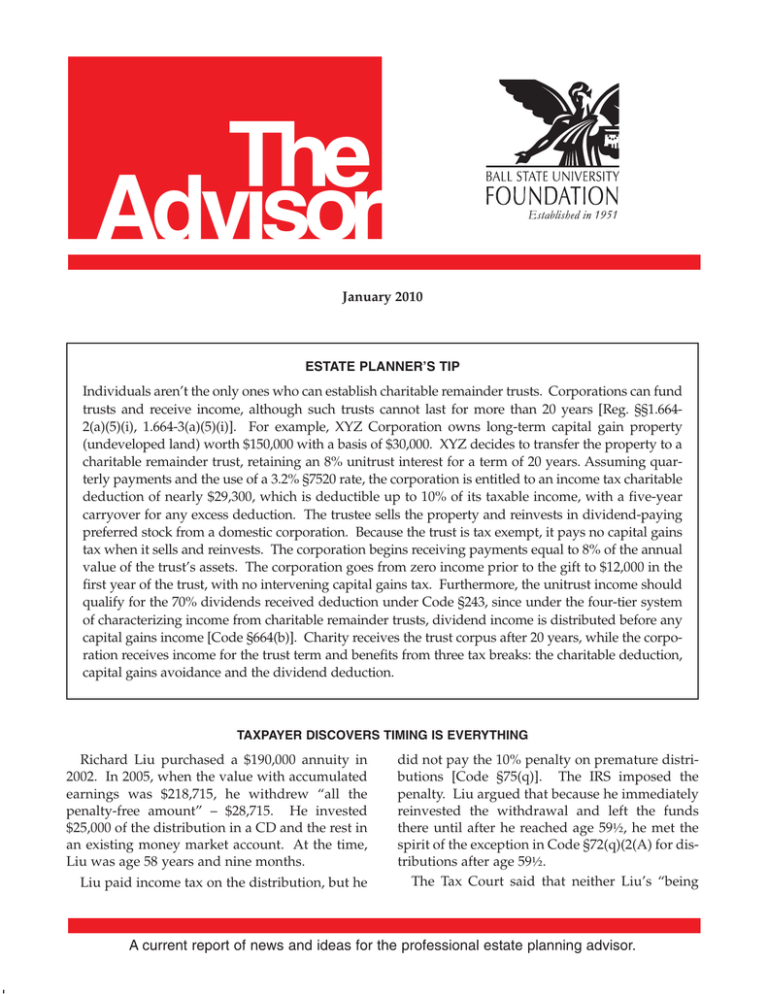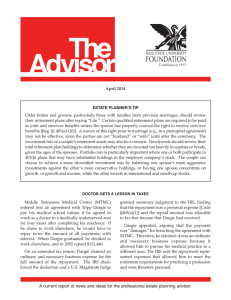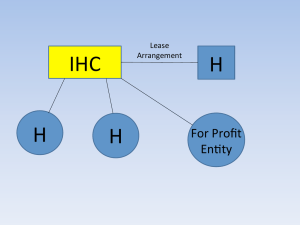The Advisor |
advertisement

The| Advisor January 2010 ESTATE PLANNER’S TIP Individuals aren’t the only ones who can establish charitable remainder trusts. Corporations can fund trusts and receive income, although such trusts cannot last for more than 20 years [Reg. §§1.6642(a)(5)(i), 1.664-3(a)(5)(i)]. For example, XYZ Corporation owns long-term capital gain property (undeveloped land) worth $150,000 with a basis of $30,000. XYZ decides to transfer the property to a charitable remainder trust, retaining an 8% unitrust interest for a term of 20 years. Assuming quarterly payments and the use of a 3.2% §7520 rate, the corporation is entitled to an income tax charitable deduction of nearly $29,300, which is deductible up to 10% of its taxable income, with a five-year carryover for any excess deduction. The trustee sells the property and reinvests in dividend-paying preferred stock from a domestic corporation. Because the trust is tax exempt, it pays no capital gains tax when it sells and reinvests. The corporation begins receiving payments equal to 8% of the annual value of the trust’s assets. The corporation goes from zero income prior to the gift to $12,000 in the first year of the trust, with no intervening capital gains tax. Furthermore, the unitrust income should qualify for the 70% dividends received deduction under Code §243, since under the four-tier system of characterizing income from charitable remainder trusts, dividend income is distributed before any capital gains income [Code §664(b)]. Charity receives the trust corpus after 20 years, while the corporation receives income for the trust term and benefits from three tax breaks: the charitable deduction, capital gains avoidance and the dividend deduction. TAXPAYER DISCOVERS TIMING IS EVERYTHING Richard Liu purchased a $190,000 annuity in 2002. In 2005, when the value with accumulated earnings was $218,715, he withdrew “all the penalty-free amount” – $28,715. He invested $25,000 of the distribution in a CD and the rest in an existing money market account. At the time, Liu was age 58 years and nine months. Liu paid income tax on the distribution, but he did not pay the 10% penalty on premature distributions [Code §75(q)]. The IRS imposed the penalty. Liu argued that because he immediately reinvested the withdrawal and left the funds there until after he reached age 59½, he met the spirit of the exception in Code §72(q)(2(A) for distributions after age 59½. The Tax Court said that neither Liu’s “being A current report of news and ideas for the professional estate planning advisor. The Advisor close in age” nor his advisers’ failure to explain the penalty that would apply excused him from the premature distribution penalty. Congress intended to defer recognition of annuity income, provided the annuity was used for long-term investing. The 10% penalty is designed to discourage the use of annuities for short-term investments and income tax deferral. The reinvestment of the distribution into other investments vehicles generating interest income does not qualify as an exchange for another annuity that would have provided for continued deferral [Code §1035]. There was no like-kind exchange, said the court, and Liu was subject to the 10% penalty (Liu v. Comm’r., T.C. Summ. Op. 2009-137). PARTIAL DISCLAIMER YIELDS FULL DEDUCTION Helen Christiansen’s entire estate passed to her daughter, Christine. If Christine disclaimed any portion, 75% was to pass to a lead trust and 25% would go to a family foundation. Christine executed a partial disclaimer after her mother’s death for any amount in excess of $6.35 million as finally determined for federal estate tax purposes. The IRS found the value of the estate to be higher than originally claimed. The increase meant that the amounts passing to the foundaPHILANTHROPY PUZZLER Sally is the executor for her uncle’s estate. His will contained several specific bequests to favorite charities. Included in the estate inventory was $100,000 of U.S. savings bonds with unreported interest. The accountant told Sally that the interest is considered income in respect of a decedent and that family members who receive the bonds will owe income tax [Code §691(a)(1)]. Sally asked whether she could use the bonds to satisfy the charitable bequests, since charities are tax-exempt. Will this work? tion and lead trust were increased. The estate claimed a higher deduction for the value passing to the foundation. The Tax Court allowed the deduction for the added amount passing to the foundation, but determined that the estate was not entitled to a deduction for the disclaimed amount passing to the lead trust because Christine did not disclaim her contingent remainder interest. (Estate of Christiansen v. Comm’r., 130 T.C. No. 1). The IRS appealed, arguing that the overall value of the estate was “finally determined” only after the IRS’s successful challenge of the amount, not at the time of Christiansen’s death. Therefore, the transfer to the foundation was dependent upon a precedent event, in violation of Reg. §20.2055-2(b)(1). The IRS also said that allowing fractional disclaimers was against public policy, because the IRS would have no incentive to audit estate tax returns where post-challenge adjustments increasing the estate’s value would result in increased charitable deductions. The U.S. Court of Appeals (8th Cir.) said that the IRS failed to distinguish between post-death events that change the actual value of an estate and events that are merely part of the legal or accounting process of determining value at the time of death. Because the only uncertainty was the value of the foundation’s right to receive 25% of the estate in excess of $6.35 million, the disclaimer was valid. The court acknowledged that the Tax Court’s ruling could “marginally detract” from the IRS’s incentive to audit estates, but added that the IRS’s role is “not merely to maximize tax receipts and conduct litigation based on a calculus as to which cases will result in the greatest collection.” Rather, the role is to enforce tax laws. Congress encourages charitable donations through the deduction, and allowing fixed-dollar amount partial disclaimers supports this policy, said the court. Further, the IRS is not the only mechanism to prevent undervaluation. Contingent beneficiaries and state and federal laws governing fiduciary obligations also serve as a watchdog function, said the court (Estate of Christiansen v. Comm’r., No. 08-3844). The Advisor TORT CLAIM NOT SUBJECT TO PROBATE LIMITATION Following Grace Ellis’ 2003 death, a will executed in 1999 was admitted to probate. More than two years later, Shriners Hospital for Children learned that it was the primary beneficiary under a 1964 will executed by Ellis. Shriners brought suit challenging the validity of the will. The 1999 will was the result of undue influence by Ellis’ pastor, James Bauman, according to the suit. Bauman was the primary beneficiary of the 1999 will and had purportedly received inter vivos transfers from Ellis of more than $1 million. Shriners’ suit included a claim of tortious interference with an expectancy of inheritance, asking more than $2 million in compensatory damages, an accounting of all lifetime gifts and punitive damages. The circuit court dismissed the action, citing Illinois’ six-month limitation on will challenges. Shriners appealed only the dismissal of the tort action. The appeals court affirmed the lower court’s holding, noting that the allegations in Shriners’ tort claim were “virtually identical” to those in the will contest. The legislature could not have intended to bar a will contest as untimely after six months but allow the same allegations in a tort action, said the court. The Illinois Supreme Court reversed, noting that the single issue in a will contest is whether the writing is the will of the decedent. The relief sought is the setting aside of a will. In a tort claim for intentional interference with inheritance, the relief is a judgment against an individual for the benefits acquired by the tort. Some evidence may overlap between a will contest and a tort claim, said the court, but merely setting aside the will would not have addressed Shriners’ claims concerning inter vivos gifts made to Bauman. In general, a claim of tortious interference cannot be pursued if adequate relief is available in a probate proceeding, noted the court. However, Shriners did not learn of its interest under the earlier will until the validity of the 1999 will was established. Therefore, Shriners never had the opportunity to challenge the will, and even if it had, the will contest alone might not have fully compensated it, due to lifetime transfers which depleted Ellis’ estate (In re Estate of Ellis, Docket. No. 106461). INCOME: NO, DEDUCTION: YES A local charity purchases scrip at a discount over face value. It then sells the scrip to individuals at face value, giving them the option of receiving in cash the difference between the face value and charity’s cost or allowing charity to retain the difference. Sam plans to purchase scrip from the charity and elect not to receive the cash. As a result, charity will keep the difference. The IRS was asked whether Sam will recognize income in the amount of the difference because he has the option to receive the cash, and whether he is entitled to a charitable deduction for the value charity retains. In general, a rebate received by a buyer is an adjustment in purchase price, not an accession to wealth, and is therefore not included in the buyer’s gross income [Rev. Rul. 76-96, 1976-1 C.B. 23, as modified by Rev. Rul. 2005-28, 2005-1 C.B. 997]. Sam will not have income for the potential rebate he could have received. A charitable contribution must be made voluntarily and with donative intent [U.S. v. American Bar Endowment, 477 U.S. 105 (1986)]. The opportunity for Sam to elect whether rebates will be retained by the charity or received in cash makes the payments voluntary, said the IRS. Therefore, if Sam allows charity to retain the difference, he is treated as making a gift of the refundable amount in the taxable year he would have received the cash (Ltr. Rul. 200945022). PUZZLER SOLUTION When charity receives U.S. savings bonds at death, the income tax generally can be avoided. However, if savings bonds are used to satisfy pecuniary bequests, it is considered a sale or exchange of the property [Keenan v. Comm’r., 114 F.2d 217]. The estate would recognize the unreported increment in the redemption price and pay income tax. There is an exception if the bonds are included in the residue and the entire residue passes to charity [Reg. §1.691(a)-4(a)]. If the will had directed that the charitable bequests were to be satisfied using the bonds, the tax could have been avoided. The Advisor BRING LIFE TO INSURANCE GIFTS Few donors consider the potential of life insurance as a charitable giving tool. Some life insurance gift techniques are obvious, such as designating charity as the beneficiary of a policy or contributing a policy to charity. Others, however, are more creative and offer the donor a variety of benefits: Replacing assets given in trust. Fred has $100,000 of low-yielding securities with a basis of $40,000. If he sells the shares outright, he would pay tax on the $60,000 gain. He would like to make a gift of the stocks to charity but, owing to family commitments, Fred needs the $100,000 back someday. He can still make a sizable gift to charity by funding a charitable remainder trust with the appreciated shares. The trustee would sell the shares in order to pay the trust income, but there would be no tax on the gain. Not only does Fred get a charitable deduction, but his immediate cash flow situation improves. With the added income and the savings from his tax deduction, he can purchase a $100,000 life insurance policy to replace the value of the contributed assets in his estate. If his estate will be subject to federal estate tax, Fred could create an irrevocable life insurance trust, funding it with annual gifts to pay the premiums, which will keep the proceeds out of his gross estate at death. Contribution of old policies. Gloria has a paidup $50,000 life insurance policy. Her husband died recently and her only child is financially independent, so she no longer needs the policy to protect her family. She could cash it in, but David W. Bahlmann, J.D. President/CEO instead, Gloria decides to give the policy to her husband’s favorite charity as a memorial gift. She gets a deduction in the year of the gift for the interpolated terminal reserve value (roughly the cash value). Using a policy to fund a unitrust. Howard created a charitable remainder trust, funding it with a new $100,000 insurance policy on his life. His wife Greta is the income beneficiary, with his alma mater the remainder beneficiary. The unitrust pays Greta the lesser of the trust’s net income or 5% of the value of the trust assets each year. During Howard’s life, Greta may receive little or nothing from the trust, but at his death, the trust would receive the $100,000 proceeds from the policy and she would begin receiving income at the time she needs it most. The trust may also include make-up language allowing the trustee to pay Greta additional amounts equal to the payouts she did not receive in earlier years. Excess group life coverage. George enjoys group term life insurance as an executive benefit, but he has to pay tax on the value of the policy exceeding $50,000. He can eliminate that tax by contributing the excess portion of the coverage to charity. Code §79(b)(2) provides that there is no tax on excess coverage if a charity is the sole beneficiary of the amount exceeding $50,000 for the entire year. Even if George doesn’t want to make charity the beneficiary of the entire excess amount, he can reduce his tax by earmarking a portion of the excess to charity. BALL STATE UNIVERSITY FOUNDATION P.O. Box 672, Muncie, IN 47308 (765) 285-8312 • (765) 285-7060 FAX Toll Free (888) 235-0058 www.bsu.edu/bsufoundation Philip M. Purcell, J.D. Vice President for Planned Giving and Endowment Stewardship If you know another professional advisor who would benefit from this publication, please contact The Foundation.




